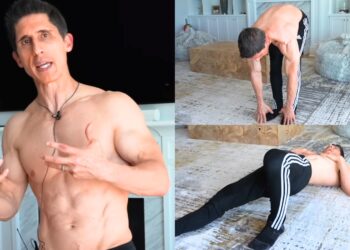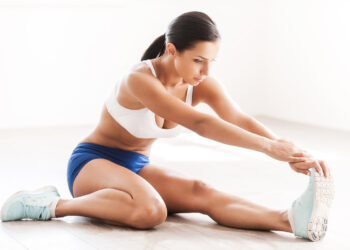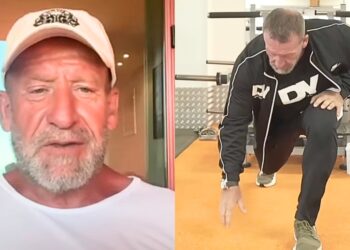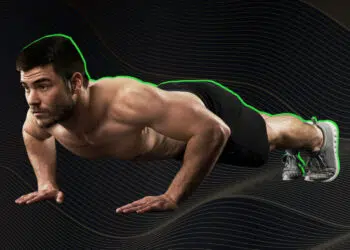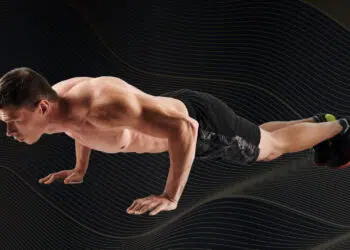Technology has a lot of benefits. For example, things like cars, cranes, and computers allow humans to save energy, perform tasks faster, and enjoy longer, safer, and more fulfilling lives.
However, some technological advancements can also have a negative effect. They can make us lazy, reduce levels of daily physical activity, and cause weight gain and muscle weakness.
Smartphones, laptops, and tablets can be good and bad for us in equal measure. On the one hand, they make long-distance communication easier than ever before, and you have a world of information at your fingertips.
But, on the other hand, lengthy periods spent using devices with a screen or keyboard can do horrible things to your posture.
The more you hunch over to use your device, the more likely you are to develop a perma-hunch when you are not using it. Your shoulders become rounded, your chest collapses inward, your head juts forward, and your upper arms turn toward the midline of your body. Read also about the exercises to fix your nerd neck and desk slouch.
Poor posture can affect everything from your ability to breathe properly to your neck and shoulder health to your athletic performance and even your confidence.
Level Up Your Fitness: Join our 💪 strong community in Fitness Volt Newsletter. Get daily inspiration, expert-backed workouts, nutrition tips, the latest in strength sports, and the support you need to reach your goals. Subscribe for free!
The good news is that just a few minutes of stretching per day can reduce the damaging effects of all this screen time. You just need to do it consistently. The best exercises for consistency are those that are easiest to perform.
In this article, we explain why and how to do chest openers, which could be the perfect antidote to all that screen-hunching.
Chest Openers – Muscles Worked
Chest openers are an exercise twofer. Firstly, they stretch your chest and shoulders to improve muscle flexibility and joint range of motion. Secondly, they gently strengthen the muscles of your upper back. This makes them ideal for breaking up long periods of slouching over your screen or keyboard.
The muscles most affected by chest openers are:
Pectoralis major
Known as the pecs for short, this is your main chest muscle. The pecs are a large, fan-shaped muscle that attaches your upper arm to your shoulder joint. Prolonged hunching puts this muscle in a shortened position while chest openers stretch it out.
The pecs have three sets of fibers, called heads. They are:
- Clavicular head – upper chest
- Sternal head – middle chest
- Abdominal/costal head – lower chest
All three pec heads are stretched during chest openers, but you can target different sets of fibers by adjusting the angle of your arms.
Deltoids
The deltoids are your shoulder muscles. Like the pecs, there are three groups of fibers or heads.
- Anterior head – front shoulder
- Medial head – side shoulder
- Posterior head – rear shoulder
For the most part, chest openers stretch the anterior head and strengthen the posterior head. The medial head is not very active during chest openers.
Trapezius and rhomboids
The trapezius and rhomboids are your upper back muscles. Together, they control your scapulae or shoulder blades. The trapezius comprises three sets of fibers – upper, middle, and lower. The rhomboids are located below and work with the middle trapezius.
Chest openers will help strengthen your middle traps and rhomboids, which are important postural muscles.
Rectus abdominis
Located on the front of your abdomen, the rectus abdominis can become short and tight when you spend a lot of time hunched over a keyboard. Chest openers provide a mild but welcome stretch for what is often an overly tight muscle. The functions of the rectus abdominis are flexion and lateral flexion of the spine.
Chest openers are also an excellent shoulder mobility exercise. Mobility is your ability to actively move your joints through a wide, natural range of motion. While muscle flexibility plays a part in mobility, strength and joint health also matter.
How to Do Chest Openers
Get more from chest openers while keeping your risk of injury to a minimum by following these guidelines:
- Stand with your feet shoulder-width apart, arms by your sides. Relax your shoulders and stand tall in good posture. Look straight ahead.
- Raise your arms forward so they’re parallel to the ground. Your palms should face inward.
- Open your arms to form a T-shape. Push your hands slightly behind your shoulders.
- Arch your upper back and expand your chest a little further. Lean back and look up toward the ceiling. Hold this position for 3-5 seconds.
- Return to the starting position and repeat.
Pro Tips:
- Check the area around you to ensure you have sufficient space to perform this exercise safely.
- Increase your range of motion as you feel your mobility improve and your chest starts to open.
- Do this exercise several times a day, especially after prolonged sitting.
- Rotate your palms up and back to stretch the medial shoulder rotators, which are often tight.
- Link your movements to your breath. Inhale as you open your arms, and exhale as you return to the starting position.
- If preferred, you can also do this exercise in a tall kneeling or seated position.
- Do 6-10 slow, smooth repetitions per set.
Chest Opener Benefits and Drawbacks
Not sure if chest openers are worth doing? Check out these benefits and then decide!
Anywhere, anytime
This chest opener exercise requires no equipment, so you can do it wherever and whenever you want. As such, it’s the perfect excuse-free exercise for stretching your chest, strengthening your upper back, and mobilizing your shoulders.
A great way to break up long periods of inactivity
Many people earn their living sitting at a desk in front of a computer. They also spend their leisure time sitting. All this chair time can wreak havoc on your posture. Chest openers are a convenient way to get your upper body moving and break up long periods of sitting. You don’t even have to stand up and can do this exercise while sitting at your desk.
A safe and simple exercise
Providing you have no underlying shoulder problems, the chest opener should do nothing but good for your posture and joints. There is a very low risk of injury. It’s also a simple exercise that’s ideal for beginners and less-fit individuals.
While chest openers are a mostly beneficial exercise, there is also a drawback to consider:
A good stretch but a less effective strengthening exercise
Any resistance for your upper back muscles comes from the tightness in your chest and shoulders. As such, this exercise does not provide much overload for your trapezius, rear deltoids, and rhomboids. So, while any exercise is better than none, if you want a stronger upper back, you’ll need to target it directly with specific strengthening exercises.
7 Chest Opener Variations and Alternatives
Chest openers are a highly effective mobility and flexibility exercise, but that doesn’t mean you need to do them all the time. There are several variations and alternatives you can use to keep your workouts productive and interesting:
1. Seated desk chest opener
It’s not always practical to stand up, take a break from work, and stretch your chest with your arms extended outward. If your boss is watching or you work in a small cubical, you may be unable to do the chest opener shown above. However, that doesn’t mean you can’t open your chest. This simple exercise is a compact and convenient way to stretch your pecs without leaving your desk.
Level Up Your Fitness: Join our 💪 strong community in Fitness Volt Newsletter. Get daily inspiration, expert-backed workouts, nutrition tips, the latest in strength sports, and the support you need to reach your goals. Subscribe for free!
Steps:
- Sit up tall and place your hands on your neck.
- Gently round your upper back forward and bring your elbows together.
- Next, sit up tall, retract your shoulders, and press your elbows out and back to open your chest.
- Alternate smoothly between these two positions for 6-10 reps.
Muscles Targeted:
- Stretch: Pectoralis major, anterior deltoids, rectus abdominis.
- Strengthen: Posterior deltoids, trapezius, rhomboids.
Benefits:
- No need to leave your desk.
- A good chest opener and thoracic spine mobilizer.
- You can even do this exercise in your car, e.g., when sitting in traffic but NOT while driving!
Tips:
- Avoid pulling on your neck, as this could cause injury.
- Do 5-10 reps of this exercise every hour you spend at your desk. Set an alarm!
- Increase your range of motion as you feel your chest start to loosen and open.
2. Standing chest opener V2
There is more than one way to perform chest openers. This version hits your pecs and delts from a slightly different angle. Try them both and see which one you feel the most. Whichever feels most difficult is probably the best one for you to focus on.
Steps:
- Stand in good posture and clasp your hands behind your back. Retract your shoulders and lift your chest. Look straight ahead.
- Press your elbows back to open your chest and stretch your shoulders.
- Hold for 20-60 seconds, and then relax.
Muscles Targeted:
- Stretch: Pectoralis major, anterior deltoids, rectus abdominis.
- Strengthen: Posterior deltoids, trapezius, rhomboids.
Benefits:
- An easier alternative to regular chest openers.
- You can do this exercise whenever and wherever you want.
- An excellent exercise for breaking up long periods of sitting.
Tips:
- Lift your hands away from your body to increase the stretch.
- Push your hands down toward the floor to open your shoulders more.
- Hold a towel instead of clasping hands to make this exercise easier.
3. Corner/doorway chest opener
Some chest openers rely on the strength of your upper back to work. That’s fine if you have well-conditioned back muscles or only want a mild stretch. But if you’re going to stretch deeper, you may need to use something else to push your arms back. In this exercise, that something is the corner of a room.
Steps:
- Stand facing a corner of a room. Bend your arms to 90 degrees and place your forearms on the walls on either side of your chosen corner. Your elbows should be level with your shoulders.
- Push your chest forward to gently stretch your pecs and shoulders.
- Hold this position for 30-60 seconds, and then relax.
Muscles Targeted:
- Stretch: Pectoralis major, anterior deltoids.
- Strengthen: N/A.
Benefits:
- A convenient way to get a deeper chest stretch.
- Ideal for contract/relax stretches.
- A convenient, comfortable stretch.
Tips:
- Adopt a split stance for balance.
- Press your arms forward for 5-10 seconds, and then relax into a deeper stretch.
- You can also do this exercise in an open doorway.
- Increase your range of motion as you feel your muscles relax.
4. Banded chest opener
This exercise is also known as shoulder dislocations, but don’t let that put you off. In actuality, this is a great chest opener that is also very good for your shoulder mobility and joint health. Using a band means you can modify the angle of your arms, adjusting the exercise to your abilities and needs.
Steps:
- Hold a resistance band with an overhand, wider-than shoulder width grip.
- Stand in good posture.
- Lift your arms forward, overhead, and then down behind you. Move your hands as far apart as necessary to achieve this.
- Return to the starting position and repeat for 6-10 slow, controlled reps.
Muscles Targeted:
- Stretch: Pectoralis major, anterior deltoids, rectus abdominis.
- Strengthen: Posterior deltoids, trapezius, rhomboids.
Benefits:
- An excellent exercise for upper body warm-ups.
- Good for improving mobility and stability.
- Scalable by using different strength bands.
Tips:
- Start with a light band and increase as you get stronger.
- Move your hands inward as your mobility improves.
- You can also do this exercise with a towel, rope, or yoga strap.
5. Foam roller chest opener
Most people use foam rollers for self-myofascial release, which is a form of soft tissue massage. However, you can also use a foam roller as a prop or support for passive stretching. This chest opener is very relaxing and ideal for easing tension and stress from the target muscles.
Steps:
- Lie on a foam roller so it runs lengthways down your spine. The end of the roller should be at the base of your skull to support your head.
- Bend your legs and plant your feet firmly on the floor for balance.
- With your elbows bent to 90 degrees, bring your forearms together over your chest.
- Open your arms and lower your arms down toward the floor. Hold for 10-20 seconds.
- Bring your forearms back together and then lower them again
- Repeat for 6-10 reps until your chest feels open and relaxed.
Muscles Targeted:
- Stretch: Pectoralis major, anterior deltoids.
- Strengthen: N/A.
Benefits:
- A passive stress opener that helps relax your muscles.
- An excellent cool-down exercise.
- Using a foam roller automatically puts you into good posture.
Tips:
- Increase your range of motion as you feel your chest start to open and relax. Larger-diameter foam rollers work best for this exercise.
- Tall people may need to put a yoga block behind their heads for support.
- Extend your arms out straight to change the angle of the movement.
6. Side-lying chest opener
Most chest openers affect both sides of your chest at once. While this is not a bad thing, it could be a problem if one side of your pecs is a lot tighter than the other. Side-lying chest openers address one side of your chest at a time and also mobilizes your thoracic spine, making it a very valuable exercise.
Steps:
- Lie on your side with your knees bent and arms extended along the floor at shoulder level. Use a mat for comfort.
- Lift your uppermost arm and reach back toward the floor behind you, rotating your upper body and looking at your outstretched arm as you go.
- Return to the starting position and repeat for 6-10 reps.
- Rest, roll over, and repeat.
Muscles Targeted:
- Stretch: Pectoralis major, anterior deltoids, rectus abdominis, obliques.
- Strengthen: N/A.
Benefits:
- This exercise will identify and fix left-to-right flexibility imbalances.
- Good for mobilizing your thoracic spine or upper back.
- A relaxing movement that’s ideal for cool-downs.
Tips:
- Link your movements to your breaths, inhaling as you open your arms and exhaling as you return to the starting position.
- Increase your range of motion as your muscles relax.
- Lie on a mat for comfort. Place cushions under your hips, shoulders, and head if required.
7. Band pull-aparts
While chest openers are an excellent exercise for increasing your shoulder mobility and stretching your chest, they are not so good for strengthening your upper back. Still, you need strong upper back muscles to hold you in good posture and resist the pull of gravity. Band pull-aparts combine the stretching effect of chest openers with an excellent upper back strengthening exercise.
Steps:
- Stand in good posture and look straight ahead.
- Hold a resistance band with an underhand, shoulder-width grip. Raise your arms in front of you so your hands are level with your shoulders.
- Open your arms and stretch the band out across your chest, forming a T-shape. Pause for 2-3 seconds.
- Bring your arms back together and repeat.
Muscles Targeted:
- Stretch: Pectoralis major, anterior deltoids.
- Strengthen: Posterior deltoids, trapezius, rhomboids.
Benefits:
- A great warm-up before upper body strength training.
- A very effective postural exercise.
- Good for all aspects of shoulder health.
Tips:
- Move your hands closer together to make this exercise more demanding.
- Use a thicker band as you get stronger.
- You can also do this exercise with an overhand grip if you prefer.
FAQs
Do you have a question about chest openers? No problem, because we’ve got the answers!
1. How often should I perform chest openers?
Performed correctly, chest openers (and all the variations and alternatives in this article) are very low intensity. As such, you can do them daily or even several times a day if you wish.
For example, you could do a set of chest openers every hour you are at work to improve your posture and keep your chest and shoulders supple and mobile. You could also do them on rising, before bed, or any other time you feel tight or stiff.
So, do chest openers as often as you wish.
2. Chest openers hurt my shoulders – what gives?
The main reason that chest openers could hurt your shoulders is if you are forcing your arms back too far. This would put a lot of stress on the tendons and ligaments of your shoulders as well as the joint itself.
Reduce your range of motion and only increase it as your mobility improves.
If your shoulders still hurt, you may benefit from a medical examination to see if there is an underlying problem that’s causing the pain. For example, you may have arthritis, tendonitis, or some other source of inflammation.
3. Will chest openers give me bigger muscles?
Chest openers will not give you bigger muscles. They involve no real overload and are not fatiguing enough to build muscle or make you significantly stronger. However, doing chest openers will help improve your posture, and better posture often makes your upper body look more impressive. Simply pulling your shoulders back and standing tall makes your chest look bigger.
4. What is the best way to stop my posture from worsening?
Posture is the alignment of your joints, and it can be good or bad. Prolonged sitting, muscle tightness on the front of your body, and weak muscles on the back of your body can cause you to slouch and round your shoulders.
The good news is that you can reverse this trend by performing strategic stretching and strengthening exercises.
You’ll need to stretch your pecs, anterior deltoids, abs, and shoulder internal rotators while strengthening your upper back, posterior deltoids, and spinal erectors.
Additionally, you need to become more posturally aware, taking care not to slouch as much. This will require a lot of effort initially but gradually sitting and standing in good posture will become a habit.
Check out this article to find out more about fixing poor posture.
5. Are chest openers necessary?
Chest openers are an excellent exercise, but not everyone needs to do them. Suppose you have good posture, a flexible chest, and healthy shoulders. In that case, this exercise may be unnecessary and offer no real benefits.
However, if you spend time sitting at a desk or have any upper body mobility limitations, chest openers will probably help.
If nothing else, chest openers are a great way to warm up your upper body before hitting the weights.
So, chest openers are not strictly necessary, but they can be very useful.
Chest Openers – Wrapping Up
Chest openers are a very simple exercise, but don’t let that fool you into thinking they are pointless. This straightforward movement can help reverse the adverse effects of prolonged sitting by stretching your pecs and mobilizing your shoulders. It’s also a great way to warm up before lifting weights.
So, start doing chest openers whenever you’ve been sedentary for a time. Just a few reps every hour or so could have a huge impact on how you look, feel, and perform.
Featured Image: OrigymPersonalTrainerCourses / YouTube


